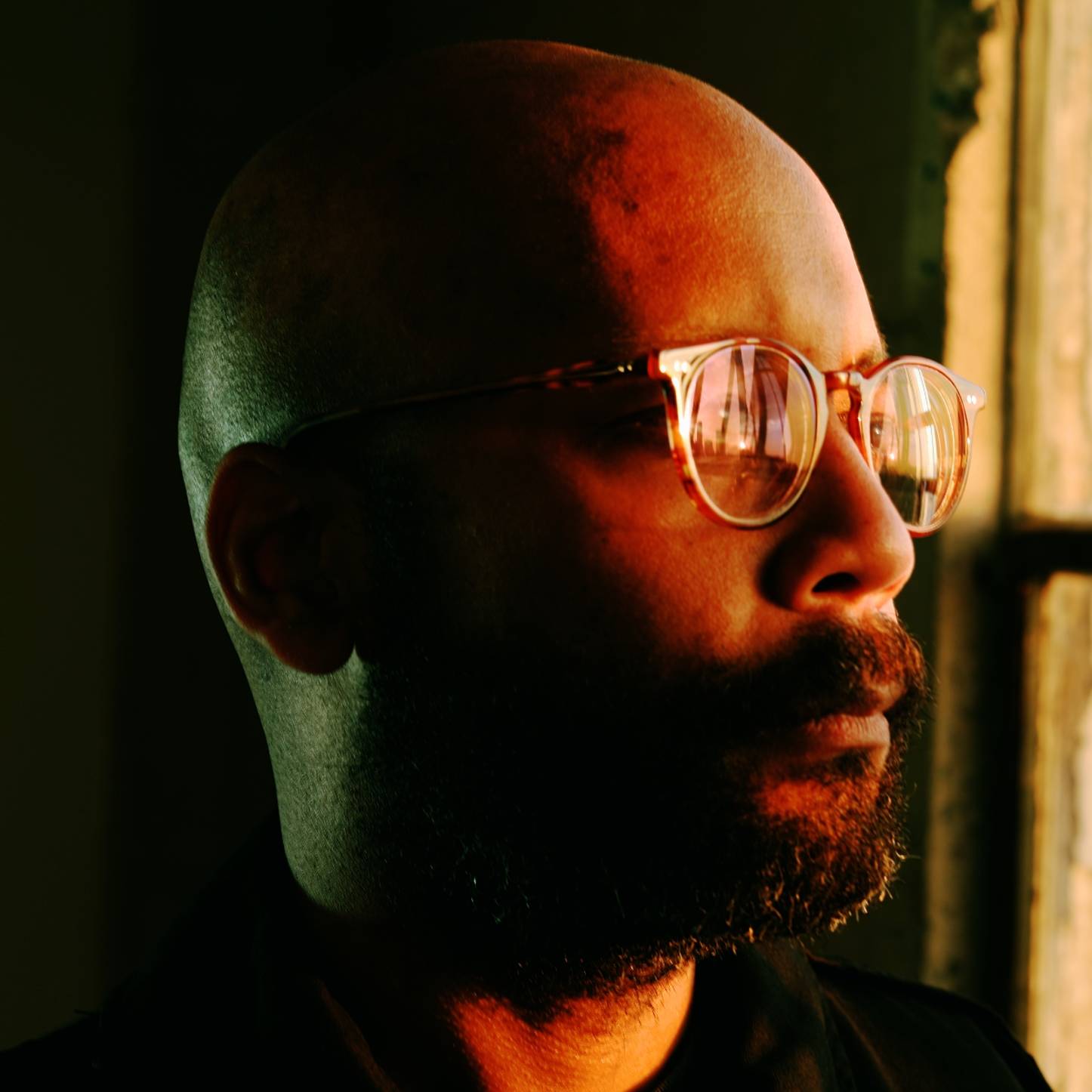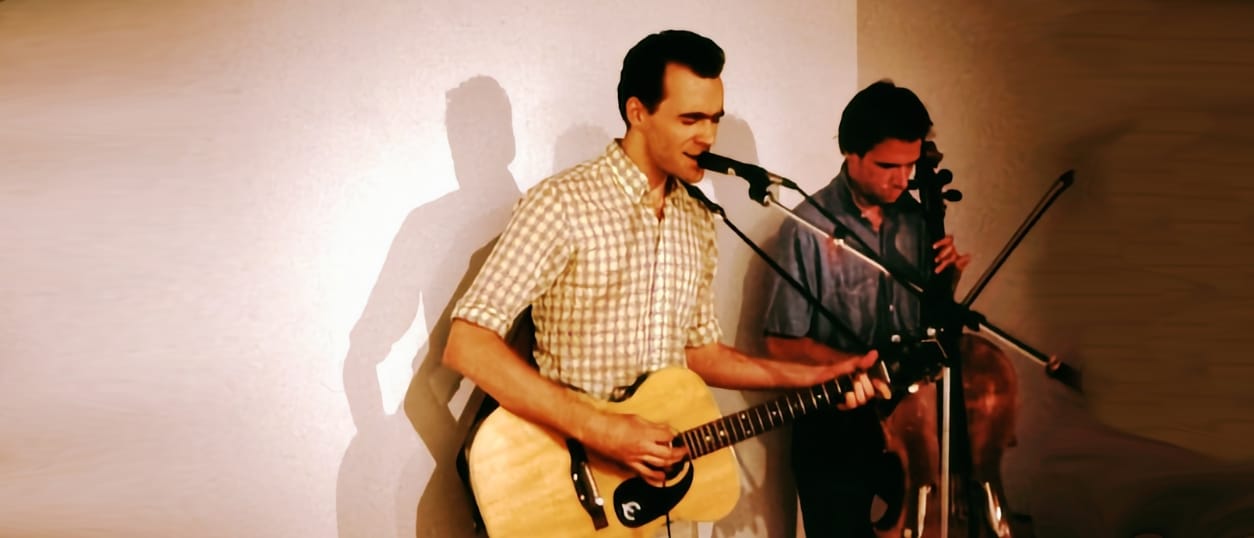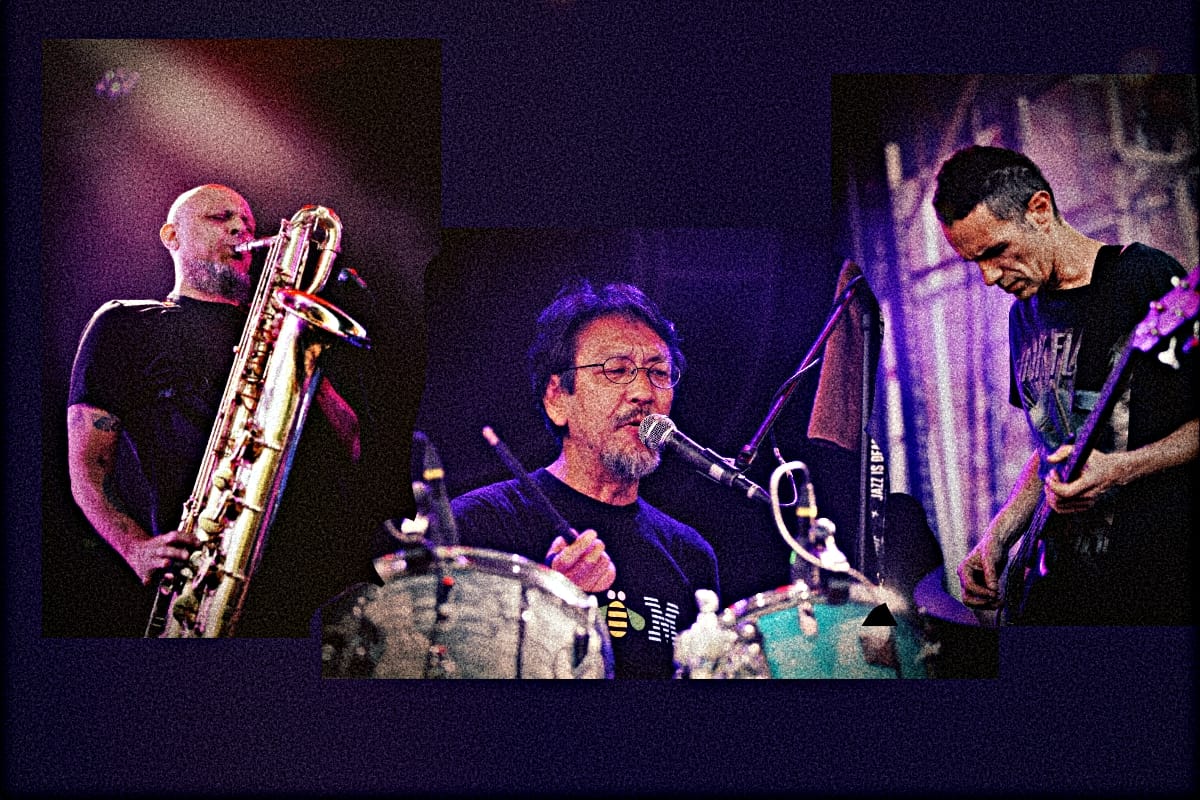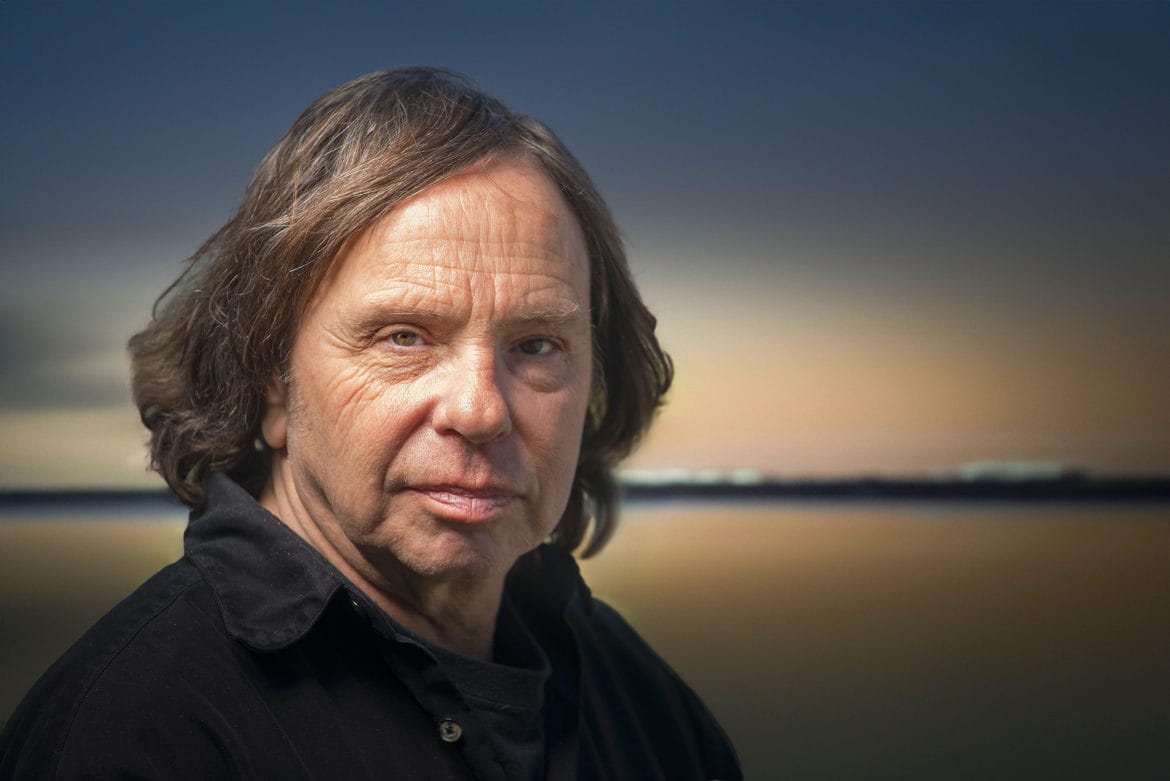Over a decade ago, César Dávila-Irizarry's distinctive perception of sound carved its way into North American consciousness with the premiere of American Horror Story. However, way before landing the theme song of the long-running horror TV series, César, born in Puerto Rico and now residing in Los Angeles, has been shattering the expectations of how sound should be understood.
Artfully merging the worlds of music and sound design, his aural experimentations have been featured in TV series, short films, live theatrical performances, and various sound installations. Furthermore, he has many releases as a solo artist under his own name and for various other projects.
Recently, my brother Juan and I spoke with César about his youth in Puerto Rico, his studies in Chicago, and his prolific work challenging the status quo around what music and sound are and who should be allowed to create them. We also touched on his most recent projects: the soundtrack to the short film planet b234, a sound installation in the city of Chicago, and his cover of a shoegaze classic.
(all artist photos by Karen Walker Chamberlin)

Miguel Bustamante: I'll start with your background and how you got started in music. I'm interested in your Puerto Rico upbringing and how that has influenced your work.
César Dávila-Irizarry: I got into music after trying to convince a friend of mine that Metallica was satanic. He said, "I don't think so. You should check out the lyrics." He had Master of Puppets as a cassette and said, "Just listen to it. I think you're actually gonna like it." I came back saying, "Oh shit, yeah, you're right." That's what interested me in music as an expression, and it had the angst.
I had my friends, but I was very much a loner. I would spend my lunchtime just listening to music. I started with Metallica, Guns N' Roses, and all that stuff. Pretty much everyone in school was listening to old-school reggaeton. I was in my little corner listening to music and being an outcast because I was so into all the nerdy stuff, like comic books and Dungeons & Dragons.
I would venture into industrial music and more electronic stuff because I was interested in how sound can be amorphous. The Downward Spiral by Nine Inch Nails really impressed me. I saw that there was no boundary between what most people understand as music and sound design. Back then, I didn't even know the term "sound design," but I knew that you could take sound to places where it was just like magic. I think there's a connection between playing Dungeons & Dragons as a kid, thinking about all these fantastical worlds, exploring my imagination, and the sounds I heard.
Juan Bustamante: Your IMDb biography says something about the influence you get from your homeland's chaotic tropical landscapes. What do you mean by 'chaotic tropical landscapes?' What were you thinking of?
César: If I'm in Puerto Rico, in my room back in my house at night, I can hear so many layers of things. I hear the crickets, I hear the coquis [a small frog native to Puerto Rico], I hear the distant highway. Maybe my mom is washing dishes or watching TV, or my stepdad watches one of the thousand crime shows. I sometimes hear gunshots because that's part of the soundscape of Puerto Rico, which I grew up with as something natural—just going to sleep with gunshots in the distance almost every night. It's just a different way to perceive things.
When I first moved to the United States, it was to the suburbs outside Chicago, to St. Charles. The silence at night was a vacuum, and that was a moment where I understood how the perception of silence differs for different people. In Puerto Rico, silence is really fucking loud, and in St. Charles, it's a vacuum.
Juan: When you went to the vacuum, did you like it, or did you miss the chaos?
César: At first, it was disturbing; it took me some time to get used to it. To just hear the AC going, it felt... It's funny. It felt the way people describe an anechoic chamber, but of course, it was not an anechoic chamber. If I had to describe it at that precise moment, I bet the words would have been very similar to someone who grows up with that vacuum of sound and then goes into an anechoic chamber.
Miguel: I want to return to your connection to angst in the music. What is that about?
César: I think it's just me reacting to how irrational the world is, also the imperfection of humanity. Humanity isn't perfect, and I want my music to reflect humanity. I subconsciously think I was always doing this from the start. Now, after different educational institutions, I can say it out loud. I can express it.
When I was studying sound, the first place where I studied for a degree was at the School of the Art Institute of Chicago, where it's mostly painters and just visual artists. They have a sound department; there's a lot in me that comes from that sound department. There's also a lot that comes from all the painters I was hanging around then. A lot of my approach is treating music and sounds the way that they treat visual art.
I have a friend who has these incredible paintings. She paints many layers and then strips some of the layers to create different forms. I used to know the scientific term for this situation: the brain is always looking for a face or a shape, like if you pour coffee, and the foam kind of looks like a face naturally. [ed: This is called pareidolia.] So, she would be exploring that with her paintings.
Miguel: So, let's touch on the obligatory: American Horror Story. Did you create this song in Puerto Rico?
César: Yeah, in that very same room I was describing.
Miguel: You shared it with a friend in '98, right? Somewhere around this time. Years pass, and he becomes a video editor.
César: Yes, for many TV shows and movies.
Miguel: He's in LA, and he's doing the title. He's creating the title sequence for the American Horror Story, and he places your song in there; how did that happen?
César: My friend, Gabriel Díaz, was given different songs that the producers told him could work with the idea they wanted. The instructions were that they wanted the titles to feel just like the trailer for The Girl with the Dragon Tattoo. The sound from that song had the old-school Broken EP sound that Nine Inch Nails was using. It's a very harsh, digital punch in the face, a constant punch in the face.
The songs he was given didn't quite work. Then he remembered this song from about thirteen years before and said, "I'm just gonna put César's song as that gives what they're looking for" from his perspective. Gabriel's boss saw the work and said, "Where did you get that from? This works perfectly! No notes. Let's just send it to the client and see what they think." Ryan Murphy loved it, so it stayed.
Miguel: Charlie Clouser from Nine Inch Nails also worked on it. How did he get involved?
César: Okay, he got involved for two reasons. One is that the song didn't have stems, and they need stems for things to go on TV. Especially for 5.1, for surround sound, you want stems so you can send things to different speakers and have more fluidity and tweak the mix that works for TV.
The other obstacle is that part of the beat was made from something I sampled. Even though I changed the sample so it didn't sound like the original, the lawyer told me, "No, you have to recreate this even though it definitely doesn't sound like the original."
Miguel: What was the sample?
César: The sample was from a song I refuse to disclose. (laughter) Just in case. I don't think there will be any problem, but I don't even want to tempt fate.
Miguel: So Charlie Clouser recreated the song from scratch?
César: Certain parts, like the bass and the percussion. Everything else, he surgically extracted from the original.
Miguel: I'm trying to process this important moment in your career. This is your first placement in a show, and it's a huge show. It's still happening; they're still creating episodes.
César: Music-wise, because sound design-wise, I had already done plenty.
Miguel: Yeah, you were how old when you recorded the original? Like eighteen, nineteen?
César: Yeah, it was '98, so I was nineteen. Yeah, I was nineteen! Shit! I thought I was older.
Juan: When you made it, do you remember why you made it? Did something encourage you to make it? Were you making it with a goal in mind?
César: I did have a goal, yes. During that time, I was experimenting with sound, and I wanted to create a song that felt like someone was ripping your heart out. I wasn't thinking about horror; I was just thinking emotionally, and a lot of people reacted like, "Yeah, that's what it sounds like!" Because of that very harsh sound, I was experimenting with morphing sounds into something different from what they were originally.
I really like the ambiguous nature of transforming things. I think it comes from being aware of how salsa music came to be what it is, which is a blend of all the traditional music that came from Africa, with rock 'n' roll, which is also a blend of things that came from Africa, with jazz, which is also a blend of things that came from Africa, but with all these Western world instruments. I am aware of the—we have to say 'melcocha'—like the huge, thick blend of things, ideas, and traditions that make salsa. Even though I don't make salsa music, I love it because I am a mix of so many things, DNA-wise. Again, it is linked to that whole thing about humans. I am reflecting on my perception of humanity, not the lack of purity.
Juan: Now, when you're given a project, you make the theme specifically for it?
César: No, not really. The one that's just strictly a theme song is the Netflix docuseries Crime Scene: The Vanishing at the Cecil Hotel. That one comes from a collection of songs that were specifically written to be considered theme songs.
Miguel: That was during the COVID-19 pandemic.
César: Yeah, in the lockdown, I was like, "I'm gonna have a couple of weeks; I need to make as many songs as possible. Use this time I'm not in my day job to make that many songs." Then, once the lockdown continued for over three weeks, I kept making music and collaborating with people.
Juan: Do you already see the visual when you make music for a video project? I was curious about your preference.
César: I think the best will be a mix of the two. As in, I get a script, and I make some music. That way, once the project is being edited, they can use that music instead of using temp scores. Then, that's given to me, and I follow the style, which is a style that I made myself, but I follow it based on the vision of the director.
Miguel: Last year, there were a couple of pretty cool music releases for you as an artist. You released a cover song under your name and the soundtrack for a movie you composed with Carlos Iván Márquez. That movie, planet b234, is now available to stream through Amazon Prime. So, a lot is going on there. How was that process for you, creating the music for that movie?
César: Carlos was the main person creating the music. I guess you could say I was a music supervisor and a sound designer. I think that helped because I was in charge of the soundscape. So I knew that, okay, if music takes center stage here, the sound has to be more subtle, or vice versa. I think that worked out, and I also contributed to the music, but I usually contributed after Carlos had put in the main ingredients.
Miguel: Why did you choose to do it that way?
César: Because we had very little time. (laughter) Originally, Jorge [Luna, a writer and actor in the film] wanted me to do both the sound design and the music. I joined in because I wanted to do the music, and that's it. I did the sound design because they couldn't find a sound designer with whom they could work.
I was like, "Alright, I'll do it, even though it's something I'm trying to step away from." We had very little time, and I said, "OK, if I'm going to do this, then let me see if Carlos is willing to work on this with me." He agreed, and we worked very well together. We've collaborated since we were teenagers on many different projects.
So we approached it that way: "You focus on the music; I'm focusing on the sound design." Every once in a while, I'll add something to the music. There were one or two songs where I was the main person. I think it was just a remix of a song we had already created for Hide the Potion [a music project where both César and Carlos compose the music].
Miguel: Very cool. How did it feel to finally release the soundtrack officially last year? Did you think it was going to happen?
César: I did think it was going to happen. I really like releasing all the stuff that I've done. Even if it's for a film, I still like releasing the soundtrack for it. It just feels nice to be done with the project and see it as a part of the community that is formed by all these artists putting their music on music platforms. It's like being part of the conversation.
Miguel: Also, last year, you released a song as César Dávila-Irizarry. You hadn't released a song as an artist since your EP, This Is for Everyone with an Accent.
César: Yeah, that was released in 2017 and was very much a reaction to the Trump presidency.
Miguel: Then you released a song in 2023: "Dagger," a cover of a Slowdive song. Talk about that.
César: I was experimenting with my voice, and I recorded it during the lockdown. I had zero plans to release it; I was just sending it to friends. After a while, I thought I could send them the file for them to enjoy privately, but it's rare for someone to be like, "Oh, I'm gonna go to my external hard drive and get that one song that César sent me." No, people would rather stream it. So I thought, "Well, let me see if I can get permission to release this." Thanks to you, Miguel, we made it happen.
Miguel: Yes, we did. We got in touch with the band through their publisher [Warp Publishing] in the UK, and we got the go-ahead.
César: We needed this permission because it's bilingual. [ed: Though most cover songs can be easily approved online with a compulsory license, legally, one is required to get direct permission when changing the character, lyrics, or language of a song.]
Miguel: I really like the production of that song. You brought it to my attention and mentioned that it sounds like it's on a cassette tape.
César: After the song was done and I listened to it later, I said, "Why not make it sound like a cassette?" 'Cause there's a part of the song that mentions noise, and then "What if I actually add this noise that sounds like tape hiss from a cassette player, and the song is from the '90s, it would blend in with the lyrics."
There's also a reverse piano. I've been trying for a long time to remember how I came up with that idea. I don't remember what inspired that other than I like doing unexpected things and manipulating sound. I think it was just a whim at the moment after recording the guitar that I was like, "Should I do pads? Or maybe I should do something more interesting and see what happens?" Then I probably made a mixdown, flipped it so it played backward, and then figured out what to play with the piano along with the backward full mix. Then, once I was done, I flipped the piano, and I treated it with reverbs and delays. That made that ambiance, which has that particular sound, but it doesn't sound like a straight-up backward piano (mimics the sound of reversed piano keys). No, it's more fluid.
Miguel: And why a bilingual cover?
César: It's just that I wish more music were bilingual and not just like one chorus in a different language. Making it bilingual allows me to turn it into something more connected to me. There have been moments in which I'm constantly switching languages in my brain. If someone asks me something in English, I might answer in Spanish and say, "Oh, wait, let me, ah, ugh," and then switch and translate what I had just said. That only happens once or twice a year, though.
Miguel: You work with performance artists, you've worked on short films, on short films that involve live actors, and stuff that's animated in very unique ways. You've also worked on sound installations. Can we talk about that? The Chicago art installation?
César: Yeah. We're still working on some details but I was told the opening will be July 20th. That is a sound art installation where I am exploring how people from a mostly Puerto Rican community in Chicago have been changed by Chicago and how being there contributes to the Chicago culture. That exchange of culture, that network that happens in that environment when people from a different place live and become part of this other place. I'm exploring that with storytelling from collaborating with members of the community and also from field recordings taken in the room where the American Horror Story song was made.
That was not planned. It was just me being there, hearing all the layers, and thinking, "I'm just going to record this for the joy of recording it." Then I was offered to make a sound art installation, and I was like, "Well, I've been having this idea for twenty years. How about we do this?" The curator was like, "I love it. Yeah, let's do it."
I manipulated it in ways that reflect the digital experience that we have these days. For many people, that's how they get to remember and re-enjoy—if that's a word—those environments by playing them on their computer or cellphone. So I added digital artifacts to those recordings and digital artistic expressions to those recordings so that the fractions of those sounds of nature, of a tropical nature at night, come through but also claim their presence in a purely digital idiom.
Juan: That's interesting! Is it only a sound piece, or are there visual components?
César: No, just a sound piece. There are going to be four speakers, one in each corner. It's going to be quadraphonic. Each one will be playing something different, but all of them work as a unit. It's about nostalgia. It's about the macro of cultures being surrounded by all of those images, sounds, and media objects. You're showered by this amalgama de cultura [amalgam of culture]. I think about how sometimes I take a macro approach to things with many layers. I like a lot of psychedelia, having your mind expanded and taken to different places.

(César Dávila-Irizarry alongside an interview-in-progress sketch by Juan Bustamante)
Juan: You once said there's a division between sound design and music. What is the difference for you?
César: When I say sound design, for the most part, I'm thinking of sound for film or TV. All of the sounds are not music. I was very focused on that for ten years. I did over 1,100 TV show episodes. I did either dialogue cleanup, which is making all this recorded sound as good as it can by taking out maybe saliva or breaths, or making different bits of sound clips sound like it's just one single sentence so that the idea that the person is trying to express feels more correct for the story. Maybe adding backgrounds, syncing footsteps, making the footsteps, and grabbing stuff.
I got burned out on sound design, and that environment has certain things that I don't like. For music, some time needs to be spent on inspiration and experimentation. Sound design doesn't always allow for that. Sound design can be more like, "We need this now!" It happens in every field, but comparing sound design and music, sound designers are thought about in the very last step of producing the thing. I admire it a lot, but I won't venture into that world anymore.
Juan: Do you still have any goals for your music?
César: I would like more theme songs. I think it would be interesting to make more films and collaborate with people I enjoy collaborating with. I want to make more art. That's it; that's the goal.
The biggest goals I had were achieved many years before American Horror Story. When I started studying, my goal was to be part of a film; I did that in '04 and '05 for a couple of independent films that were seen worldwide. Then, my goal was to get my name on TV, and that's happened. Then there came American Horror Story, which I didn't plan on. I wanted to be a part of projects that travel the world, and I've done that. Now it's just a matter of doing what I like.
Miguel: Is there an intentional message you want out there with what you're creating? Is there something you're trying to share with your music?
César: I wish Black people were more accepted when they made art that is not expected from them; that is not what the mainstream highlights from Black people. I make music that is not thought of as music made by a Black person. Different artists have struggled with that. I remember the rock band Living Colour saying they weren't being accepted in African American award shows or events because they were told they didn't belong there. It's the same thing that they were getting, without words mostly, but they were getting from the hard rock music world. So it's like, yeah, you don't fit in anywhere. But I refuse to change my style. Fuck them. I only have one life. I'll just do what I want to do.
Miguel: That's conviction.
César: Yeah, I guess I still have the angst in me.
Juan: Does that angst partly come from being Afro-Latino or Black? What do you identify with most: Puerto Rican, Latino, Black, Afro-Latino?
César: I'm Afro-Latino, I'm Latino, I'm Puerto Rican. I'm Afro-Puerto Rican, Afro-Boricua. I'm Black.
What I am not is African American, and it's based on culture. I don't identify with the things African American people identify with. I'm starting to explore a little bit of old-school R&B, and I really fucking like it! Like old school Aretha. I knew I'd like it because other artists in alternative music have been influenced by it. I see the connection, and I enjoy it.
Your donations help support us while we support independent artists and thinkers. If you like the way that sounds, please donate today. Any amount is appreciated. Thanks.







Comments